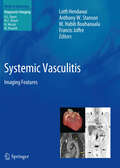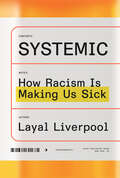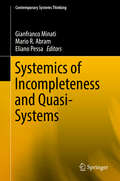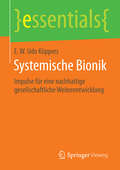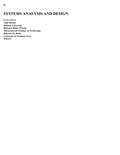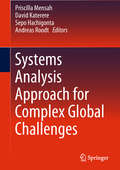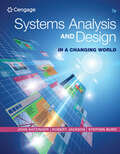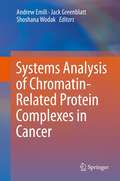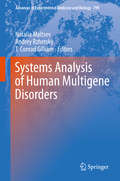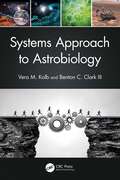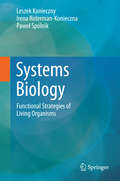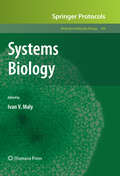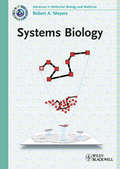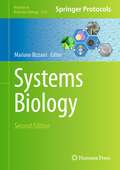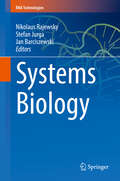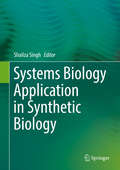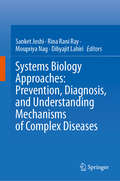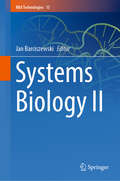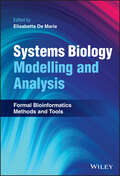- Table View
- List View
Systemic Sex Therapy
by Gerald R. Weeks Katherine Milew Hertlein Gerald Weeks Nancy Gambescia Katherine M. HertleinSystemic Sex Therapyserves as an introduction to the field of sex therapy from a systems perspective. It is an excellent resource for graduate students in marriage and family therapy programs or students and professionals who want a truly fresh perspective on sex therapy. This approach moves beyond traditional behavioral approaches to incorporate individual, couple, and intergenerational factors in etiology and treatment. Unlike current books on the market that are outdated, too advanced, simplistic, unfocused, or too diffuse in content, Systemic Sex Therapyis comprehensive, concise, highly focused on treatment, user-friendly, and contains features not found in other sex therapy texts, such as a systemic/behavioral focus, clinical innovation, and a greater focus on implementation rather than competing works.
Systemic Structural Constellations and Sustainability in Academia: A New Method for Sustainable Higher Education
by Marlen ArnoldIn order to create truly sustainable universities, we require new methods of visualising and interpreting them holistically as institutions built on complex relationships and systems, rather than as individual departments and people operating independently. This book uses a systemic structural constellations approach to demonstrate how we can build more sustainable higher education institutions, both in terms of teaching and research and at an operational level. Drawing examples from current research and teaching, Systemic Structural Constellations and Sustainability in Academia explores how universities are not only centres of teaching and learning but can also play a crucial role in enabling future decision-makers to appreciate and contribute to a more sustainable future. Providing a clear introduction to systemic structural constellations and guidance on how to practically apply the theory to numerous aspects of the higher education system, this book will be of great interest to students and researchers of education for sustainable development, organisational learning and sustainable management, as well as those tasked with transforming the higher education system for the future.
Systemic Vasculitis
by M. Habib Bouhaouala Anthony W. Stanson Lotfi Hendaoui Francis JoffreThe prompt diagnosis of systemic vasculitis is essential as a missed diagnosis can be disastrous. Imaging is of vital importance in achieving a correct diagnosis and in some cases also plays a role in endovascular treatment. In this book, the imaging features of the many different types of vasculitis are clearly demonstrated by means of numerous high-quality illustrations. All relevant imaging modalities are considered, and key distinctive characteristics are highlighted. In addition, each chapter discusses the etiology, epidemiology, pathogenesis, clinical presentation, biology, and treatment of the vasculitis in question. This book is the result of cooperation between expert teams from a range of countries. The wealth of illustrations and informative clinical case studies will prove invaluable for all who may be confronted with these problematic disorders.
Systemic: How Racism Is Making Us Sick
by Layal LiverpoolIn the spirit of Medical Apartheid and Killing the Black Body; A science-based, data-driven, and global exploration of racial disparities in health care access by virologist, immunologist, and science journalist Layal Liverpool.Layal Liverpool spent years as a teen bouncing from doctor to doctor, each one failing to diagnose her dermatological complaint. Just when she&’d grown used to the idea that she had an extremely rare and untreatable skin condition, one dermatologist, after a quick exam, told her that she had a classic (and common) case of eczema and explained that it often appears differently on darker skin. Her experience stuck with her, making her wonder whether other medical conditions might be going undiagnosed in darker-skinned people and whether racism could, in fact, make people sick.The pandemic taught us that diseases like Covid disproportionately affect people of color. Here, Liverpool goes a step further to show that this disparity exists for all types of illness and that it is caused by racism. In Systemic, Liverpool shares her journey to show how racism, woven into our societies, as well as into the structures of medicine and science, is harmful to our health. Refuting the false belief that there are biological differences between races, Liverpool goes on to show that racism-related stress and trauma can however, lead to biological changes that make people of color more vulnerable to illness, debunking the myth of illness as the great equalizer.From the problem of racial bias in medicine where the default human subject is white, to the dangerous health consequences of systemic racism, from the physical and psychological effects of daily microaggressions to intergenerational trauma and data gaps, Liverpool reveals the fatal stereotypes that keep people of color undiagnosed, untreated, and unsafe, and tells us what we can do about it.
Systemics of Incompleteness and Quasi-Systems (Contemporary Systems Thinking)
by Gianfranco Minati Mario R. Abram Eliano PessaThis book contains the proceedings of the Seventh National Conference of the Italian Systems Society. The title, Systemics of Incompleteness and Quasi-Systems, aims to underline the need for Systemics and Systems Science to deal with the concepts of incompleteness and quasiness. Classical models of Systemics are intended to represent comprehensive aspects of phenomena and processes. They consider the phenomena in their temporal and spatial completeness. In these cases, possible incompleteness in the modelling is assumed to have a provisional or practical nature, which is still under study, and because there is no theoretical reason why the modelling cannot be complete. In principle, this is a matter of non-complex phenomena, to be considered using the concepts of the First Systemics. When dealing with emergence, there are phenomena which must be modelled by systems having multiple models, depending on the aspects being taken into consideration. Here, incompleteness in the modelling is intrinsic, theoretically relating changes in properties, structures, and status of system. Rather than consider the same system parametrically changing over time, we consider sequences of systems coherently. We consider contexts and processes for which modelling is incomplete, being related to only some properties, as well as those for which such modelling is theoretically incomplete—as in the case of processes of emergence and for approaches considered by the Second Systemics. In this regard, we consider here the generic concept of quasi explicating such incompleteness. The concept of quasi is used in various disciplines including quasi-crystals, quasi-particles, quasi-electric fields, and quasi-periodicity. In general, the concept of quasiness for systems concerns their continuous structural changes which are always meta-stable, waiting for events to collapse over other configurations and possible forms of stability; whose equivalence depends on the type of phenomenon under study. Interest in the concept of quasiness is not related to its meaning of rough approximation, but because it indicates an incompleteness which is structurally sufficient to accommodate processes of emergence and sustain coherence or generate new, equivalent or non-equivalent, levels. The conference was devoted to identifying, discussing and understanding possible interrelationships of theoretical disciplinary improvements, recognised as having prospective fundamental roles for a new Quasi-Systemics. The latter should be able to deal with problems related to complexity in more general and realistic ways, when a system is not always a system and not always the same system. In this context, the inter-disciplinarity should consist, for instance, of a constructionist, incomplete, non-ideological, multiple, contradiction-tolerant, Systemics, always in progress, and in its turn, emergent.
Systemische Bionik: Impulse für eine nachhaltige gesellschaftliche Weiterentwicklung (essentials)
by E. W. Udo KüppersDieses Essential vermittelt einen grundlegenden Einblick in die Systemische Bionik als Grenzen überwindende Disziplin. Der Autor erläutert auf leicht verständliche Weise, welchen Wert die Bionik für ganzheitliche Problemlösungen bietet und welche Rolle eine intakte Natur dabei spielt. Wegweisend und zielführend bei diesem systembionischen Vorgehensmodell ist das Erkennen von Zusammenhängen in Natur und Technik.
Systemleichtbau für die Luftfahrt (essentials)
by Martin Wiedemannessentials liefern aktuelles Wissen in konzentrierter Form. Die Essenz dessen, worauf es als „State-of-the-Art“ in der gegenwärtigen Fachdiskussion oder in der Praxis ankommt. essentials informieren schnell, unkompliziert und verständlichals Einführung in ein aktuelles Thema aus Ihrem Fachgebietals Einstieg in ein für Sie noch unbekanntes Themenfeldals Einblick, um zum Thema mitreden zu könnenDie Bücher in elektronischer und gedruckter Form bringen das Fachwissen von Springerautor*innen kompakt zur Darstellung. Sie sind besonders für die Nutzung als eBook auf Tablet-PCs, eBook-Readern und Smartphones geeignet. essentials sind Wissensbausteine aus den Wirtschafts-, Sozial- und Geisteswissenschaften, aus Technik und Naturwissenschaften sowie aus Medizin, Psychologie und Gesundheitsberufen. Von renommierten Autor*innen aller Springer-Verlagsmarken.Dies ist ein Open-Access-Buch.
Systems Analysis And Design
by Alan Dennis Roberta M. Roth Barbara Haley WixomThe 6th Edition of Systems Analysis and Design continues to offer a hands-on approach to SAD while focusing on the core set of skills that all analysts must possess. Building on their experience as professional systems analysts and award-winning teachers, authors Dennis, Wixom, and Roth capture the experience of developing and analyzing systems in a way that students can understand and apply. With Systems Analysis and Design, 6th Edition, students will leave the course with experience that is a rich foundation for further work as a systems analyst.
Systems Analysis Approach for Complex Global Challenges
by Priscilla Mensah David Katerere Sepo Hachigonta Andreas RoodtThis book, which contains a collection of review articles as well as focus on evidence-based policy making, will serve as a valuable resource not just for all postgraduate students conducting research using systems analysis thinking but also for policy makers. To our knowledge, a book of this nature which also has a strong African focus is currently not available. The book examines environmental and socio-economic risks with the aim of providing an analytical foundation for the management and governance of natural resources, disasters, addressing climate change, and easing the technological and ecological transitions to sustainability. It provides scientific and strategic analysis to better understand the dynamics of future energy transitions, their main driving forces, enabling factors, barriers, as well as their consequences for the social, economic and environmental dimensions of human wellbeing. Science-based policy advice is achieved through an integrated assessment and modeling of how to simultaneously address the major energy policy challenges in the areas of environment (climate change and air pollution), energy poverty (or access to affordable and clean energy for the poor), energy security and reliability. It also aims to improve our understanding of ecosystems and their management in today’s changing world—in particular, the current state of ecosystems, and their ecological thresholds and buffering capacities. It provides support for policy makers in developing rational, realistic and science-based regional, national and global strategies for the production of fuel, food and fibre that sustain ecosystem services and safeguard food security. Finally, it addresses the human development dimension of global change based on comprehensive studies on the changing size and composition of human populations around the world by analyzing both their impacts and the differential vulnerabilities by age, gender and level of education.
Systems Analysis and Design
by Kenneth E. Kendall Julie E. KendallExpanded coverage of emerging technologies, such as agile methods, cloud computing, and mobile applications, complements this book’s traditional approaches to systems analysis and design. A wealth of real-world examples emphasizes critical thinking and IT skills in a dynamic, business-related environment. You will find numerous projects, insightful assignments, and helpful end-of-chapter exercises to help you refine the IT skills you need for success in today's intensely competitive business world.
Systems Analysis and Design in a Changing World
by Robert B. Jackson John W. Satzinger Stephen D. BurdReflecting the latest practices, trends, and developments from the field, SYSTEMS ANALYSIS AND DESIGN IN A CHANGING WORLD, 7E equips you with a solid foundation of the most important principles of systems analysis, systems design, project management, and new software development approaches. Using case driven techniques, the succinct 14-chapter book focuses on content that is key to your success in today's market. The book teaches both traditional (structured) and object-oriented (OO) approaches to systems analysis and design. It highlights use cases, use diagrams, and use case descriptions required for a modeling approach, while demonstrating their application to traditional, web development, object-oriented, and service-oriented architecture approaches. Content reflects Microsoft Project 2013 Professional and Microsoft Visio 2013.
Systems Analysis of Chromatin-Related Protein Complexes in Cancer
by Andrew Emili Shoshana Wodak Jack GreenblattEpigenetic modifications underlie all aspects of human physiology, including stem cell renewal, formation of cell types and tissues. They also underlie environmental impacts on human health, including aging and diseases like cancer. Consequently, cracking the epigenetic "code" is considered a key challenge in biomedical research. Chromatin structure and function are modified by protein complexes, causing genes to be turned "on" or "off" and controlling other aspects of DNA function. Yet while there has been explosive growth in the epigenetics field, human chromatin-modifying machines have only recently started to be characterized. To meet this challenge, our book explores complementary experimental tracks, pursued by expert international research groups, aimed at the physical and functional characterization of the diverse repertoire of chromatin protein machines - namely, the "readers, writers and erasers" of epigenomic marks. These studies include the identification of RNA molecules and drugs that interact selectively with components of the chromatin machinery. What makes this book distinctive is its emphasis on the systematic exploration of chromatin protein complexes in the context of human development and disease networks.
Systems Analysis of Human Multigene Disorders
by Natalia Maltsev Andrey Rzhetsky T. Conrad GilliamUnderstanding the genetic architecture underlying complex multigene disorders is one of the major goals of human genetics in the upcoming decades. Advances in whole genome sequencing and the success of high throughput functional genomics allow supplementing conventional reductionist biology with systems-level approaches to human heredity and health as systems of interacting genetic, epigenetic, and environmental factors. This integrative approach holds the promise of unveiling yet unexplored levels of molecular organization and biological complexity. It may also hold the key to deciphering the multigene patterns of disease inheritance.
Systems Approach to Astrobiology
by Vera M. Kolb Benton C. ClarkSystems thinking/analysis is widely applied for solving complex problems in engineering and certain other fields. Astrobiology, which inherently involves complex problems, can benefit from such an approach.
Systems Approaches to Nuclear Fusion Reactors (Springer Series in Plasma Science and Technology)
by Frederick B. MarcusThis book offers an overall review, applying systems engineering and architecture approaches, of the design, optimization, operation and results of leading fusion experiments. These approaches provide a unified means of evaluating reactor design. Methodologies are developed for more coherent construction or evaluation of fusion devices, associated experiments and operating procedures. The main focus is on tokamaks, with almost all machines and their important results being integrated into a systems design space. Case studies focus on DIII-D, TCV, JET, WEST, the fusion reactor prototype ITER and the EU DEMO concept. Stellarator, Mirror and Laser inertial confinement experiments are similarly analysed, including reactor implications of breakeven at NIF.The book examines the engineering and physics design and optimization process for each machine, analysing their performance and major results achieved, thus establishing a basis for the improvement of future machines. The reader will gain a broad historical and up-to-date perspective of the status of nuclear fusion research from both an engineering and physics point of view. Explanations are given of the computational tools needed to design and operate successful experiments and reactor-relevant machines. This book is aimed at both graduate students and practitioners of nuclear fusion science and engineering, as well as those specializing in other fields demanding large and integrated experimental equipment. Systems engineers will obtain valuable insights into fusion applications. References are given to associated complex mathematical derivations, which are beyond the scope of this book. The general reader interested in nuclear fusion will find here an accessible summary of the current state of nuclear fusion.
Systems Biology
by Bernhard Ø. PalssonGenome sequences are now available that enable us to determine the biological components that make up a cell or an organism. The discipline of systems biology examines how these components interact and form networks, and how the networks generate whole cell functions corresponding to observable phenotypes. This 2006 textbook devoted to systems biology describes how to model networks, how to determine their properties, and how to relate these to phenotypic functions. The prerequisites are some knowledge of linear algebra and biochemistry. Though the links between the mathematical ideas and biological processes are made clear, the book reflects the irreversible trend of increasing mathematical content in biology education. Therefore to assist both teacher and student, in an associated web site Palsson provides problem sets, projects and Powerpoint slides, and keeps the presentation in the book concrete with illustrative material and experimental results.
Systems Biology
by Irena Roterman-Konieczna Leszek Konieczny Paweł SpólnikThe objective of this book is to present the strategies employed by living organisms on a molecular level and to help understand the basics of Systems Biology. Its content is organized in a way to meet the exponential growth in the volume of biological knowledge, and the need for a multidisciplinary approach in the practice of teaching modern biology. For this reason, the whole material is divided into five chapters, each devoted to a fundamental concept: Structure-Function, Energy, Information, Regulation and Interrelationships. The book describes generic mechanisms which occur in biology and promotes a simulation-based approach to the subject of Systems Biology. The use of basic knowledge as the background for presenting biological problems obligates the teachers to deal with generalized phenomena comprising the ever increasing volume of teaching materials. This book is intended for biologists and is informative for specialists in the areas of computer science, robotics and engineering.
Systems Biology
by Ivan V. MalyThe rapidly developing methods of systems biology can help investigators to make inference and predictions from their data that intuition alone would not discern; however, the difficulty lies in the broad knowledge of mathematics and engineering that seems to be required to even evaluate the applicability of the methods to the problem at hand. In "Systems Biology", scientists who possess that mathematical knowledge and have applied it effectively to various biological problems contribute methods which reflect their experience, crystallized in a form very similar to typical biological laboratory protocols. In order to best aid researchers, the chapters supply the theory behind the method, its step-by-step implementation, and the pitfalls explained thoroughly and from the practical angle. As a volume of the highly successful Methods in Molecular BiologyTM series, this work provides the kind of detailed description and implementation advice that is crucial for getting optimal results. Cutting-edge and easy to use, "Systems Biology" shatters the perceived insurmountable barrier between the laboratory and systems-biological research techniques.
Systems Biology
by Robert A. MeyersSystems biology is a relatively new biological study field that focuses on the systematic study of complex interactions in biological systems, thus using a new perspective (integration instead of reduction) to study them. Particularly from year 2000 onwards, the term is used widely in the biosciences, and in a variety of contexts. Systems biology is the study of the interconnected aspect of molecular, cellular, tissue, whole animal and ecological processes, and comprises mathematical and mechanistic studies of dynamical, mesoscopic, open, spatiotemporally defined, nonlinear, complex systems that are far from thermodynamic equilibrium.Containing a unique selection of new and updated, high-quality articles from the well-known Meyer's Encyclopedia of Molecular Cell Biology and Molecular Medicine, this two-volume handbook is an essential guide for students and researchers wishing to get an overview of the field.
Systems Biology (Methods in Molecular Biology #2745)
by Mariano BizzarriThis second edition volume expands on the previous edition with discussions of the latest advancements and methods used by scientists to study systems biology. The chapters in this book are organized into four parts. Part One looks at models in systems biology and parameters identification such as short peptide analysis, metastasis models, and metabolomics. Part Two covers computational methods in the study of organisms, and cancer non-linear dynamics. Part Three discusses critical transition states across Waddington’s like landscapes such as understanding cell differentiation through single-cell approaches and modeling mammary organogenesis from biological first principles. Part Four talks about specific fields of investigation including inborn errors of metabolism, system biology approach in epithelial-mesenchymal transition, and an approach to understanding how COVID-19 spreads in the population. Written in the highly successful Methods in Molecular Biology series format, chapters include introductions to their respective topics, lists of the necessary materials and reagents, step-by-step, readily reproducible laboratory protocols, and tips on troubleshooting and avoiding known pitfalls.Cutting-edge and comprehensive, Systems Biology, Second Edition is a valuable tool for any researcher looking to learn more about this important and developing field.
Systems Biology (Rna Technologies Ser.)
by Jan Barciszewski Stefan Jurga Nikolaus RajewskyMany breakthroughs in experimental devices, advanced software, as well as analytical methods for systems biology development have helped shape the way we study DNA, RNA and proteins, on the genomic, transcriptional, translational and posttranslational level. This book highlights the comprehensive topics that encompass systems biology with enormous progress in the development of genome sequencing, proteomic and metabolomic methods in designing and understanding biological systems.Topics covered in this book include fundamentals of modelling networks, circuits and pathways, spatial and multi cellular systems, image-driven systems biology, evolution, noise and decision-making in single cells, systems biology of disease and immunology, and personalized medicine. Special attention is paid to epigenomics, in particular environmental conditions that impact genetic background. The breadth of exciting new data towards discovering fundamental principles and direct application of epigenetics in agriculture is also described.The chapter “Deciphering the Universe of RNA Structures and Trans RNA-RNA Interactions of Transcriptomes in vivo - from Experimental Protocols to Computational Analyses” is available open access under a CC BY 4.0 license via link.springer.com.
Systems Biology Application in Synthetic Biology
by Shailza SinghThis book introduces students tomethods that will help them understand behaviour in terms of cellularcomponents and their interactions in non-intuitive ways, which calls for aninterdisciplinary approach combining mathematical, chemical, computational andbiological strategies. Tibor Ganti was one of the early pioneers whoproposed a theoretical framework to understand living principles in terms ofchemical transformation cycles and their coupling. The twenty-first centurythen brought with it a novel 'systems' paradigm, which shone new light on allprevious work and was accompanied by numerous implications for the way weconceive of chemical and biological complexity today. This book seeks to equip students totake advantage of any field that investigates living systems. Based on aconceptualisation of science-oriented branches, engineering-oriented branchesand biology as astoundingly complex fields, those structures laden withbiochemical detail encompass a deeper theory unifying our knowledge of designedsystems. Readers will be pleasantly surprised athow lucidly the topics are presented. The book offers an indispensable resourcefor students and professionals working in systems and synthetic biology or anyof the various related fields of research.
Systems Biology Approaches: Prevention, Diagnosis, and Understanding Mechanisms of Complex Diseases
by Sanket Joshi Rina Rani Ray Moupriya Nag Dibyajit LahiriThis book examines the development and applications of system biology approaches for the prevention, diagnosis, and understanding of disease mechanisms. It explores the applications of system biology in infectious diseases, including host-pathogen interaction, and the identification of targets for new therapeutics and intervention strategies. It covers the use of system biology for understanding and treating metabolic disorders towards personalized and precision medicine. The book further discusses the systems biology approaches for understanding the mechanisms of tumor progression and designing more effective cancer therapies. The chapter also reviews the current strategies in autoimmune disease treatment and highlights the opportunity that systems biology represents for the development of better and safer treatments. Importantly, the book discusses the current state of the systems-level understanding of diseases and both the therapeutic and adverse mechanisms of drug actions usingsystem biology approaches. Cutting across the disciplines, this book is a valuable source for researchers in genetics, molecular biology, cell biology, microbiology, and biomedical sciences.
Systems Biology II (RNA Technologies #15)
by Jan BarciszewskiModern biology is moving away from reductionist approaches towards holistic studies that encompass whole genomes, transcriptomes, proteomes, and metabolomes. Systems biology is an approach to studying complex biological systems by looking at many biomolecules in a comprehensive way. The aim is to gain a thorough understanding of the biological functions of different classes of molecules and their interactions. Systems Biology II is an up-to-date and comprehensive guide to the latest developments in systems biology, with a particular focus on RNA-based technologies. This book is the second volume in the RNA Technologies series dedicated to this topic. It presents cutting-edge approaches and tools for modelling and analyzing complex biological systems at different levels, from molecular interactions to cellular networks and beyond. With contributions from leading experts in the field, the book covers a wide range of topics, including gene regulatory networks, epigenetics, synthetic biology, omics data analysis, network inference, and more. It explores applications in various areas of the life sciences and biomedicine, such as vaccine development, cancer research, transplantation research and pathogenic processes. This volume is an essential resource for scientists and students working in systems biology, bioinformatics, synthetic biology, and related fields, as well as anyone interested in the latest advances in RNA technologies and their applications in biology and medicine.
Systems Biology Modelling and Analysis: Formal Bioinformatics Methods and Tools
by Elisabetta De MariaSystems Biology Modelling and Analysis Describes important modelling and computational methods for systems biology research to enable practitioners to select and use the most suitable technique Systems Biology Modelling and Analysis provides an overview of state-of-the-art techniques and introduces related tools and practices to formalize models and automate reasoning for systems biology. The authors present and compare the main formal methods used in systems biology for modelling biological networks, including discussion of their advantages, drawbacks, and main applications. Each chapter includes an intuitive presentation of the specific formalism, a brief history of the formalism and of its applications in systems biology, a formal description of the formalism and its variants, at least one realistic case study, some applications of formal techniques to validate and make deep analysis of models encoded with the formalism, and a discussion on the kind of biological systems for which the formalism is suited, along with concrete ideas on its possible evolution. Edited by a highly qualified expert with significant experience in the field, some of the methods and techniques covered in Systems Biology Modelling and Analysis include: Petri nets, an important tool for studying different aspects of biological systems, ranging from simple signaling pathways to metabolic networks and beyond Pathway Logic, a formal, rule-based system and interactive viewer for developing executable models of cellular processes Boolean networks, a mathematical model which has been widely used for decades in the context of biological regulation networks Answer Set Programming (ASP), which has proven to be a strong logic programming paradigm to deal with the inherent complexity of biological models For systems biologists, biochemists, bioinformaticians, molecular biologists, pharmacologists, and computer scientists, Systems Biology Modelling and Analysis is a comprehensive all-in-one resource to understand and harness the field’s current models and techniques while also preparing for their potential developments in coming years with the help of the author’s expert insight.


